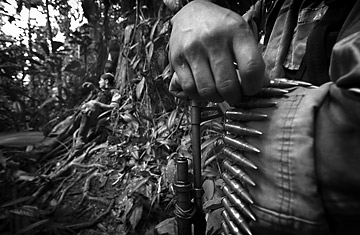
Members of a FARC unit patrol a jungle near the Pacific coast of Colombia.
The Cessna's single engine could not have failed over a worse patch of Colombian jungle. On Feb. 13, 2003, four U.S. defense contractors and a Colombian police officer, on a routine surveillance flight looking for rural cocaine laboratories, made an emergency landing in southern Colombia. The area is a stronghold of the fierce Marxist guerrillas known as the Colombian Revolutionary Armed Forces, or FARC. Rebel soldiers swarmed over the shattered plane, shooting and killing its U.S. pilot, Thomas Janis, and the Colombian officer, Luis Cruz. They stripped the remaining Americans —Keith Stansell, Thomas Howes and Marc Gonsalves — of their clothes and belongings, put the men in chains and led them toward the mountainous rain forest.
It was a march into a tropical dungeon. When the Americans' bloody foot sores made it impossible to walk, says John Pinchao, a Colombian police officer who had been held with them until he escaped last spring, their captors gave them boots so small it made their steps only more agonizing. (The rebels finally hacked off the toes of the boots with machetes to lessen the pain.) Pinchao says the men trekked for days until they reached a FARC camp in the Sierra de la Macarena, where they were initially penned together in a slung cage whose low, barbed-wire ceiling prevented them from standing up. "Despite being held together like that, [FARC guards] forbade them from talking to each other," Pinchao said in a recent deposition obtained by TIME.
Today, Stansell, 43, a former Marine, Howes, 54, a former State Department counternarcotics pilot, and Gonsalves, 35, a former Air Force intelligence officer, live in slightly better conditions, says Pinchao. Still, a video that police seized last fall from FARC operatives in the capital, Bogota, shows the men looking weak and depressed. They have now been in captivity for five years — one of the longest hostage episodes in U.S. history. Yet few Americans know about it. President George W. Bush has mentioned the hostages publicly only once, when he visited Colombia last year. "It's amazing and discouraging to think that these three guys, former U.S. servicemen, could be left behind and forgotten this way," says Lynne Stansell, Keith's stepmother, of Bradenton, Fla. "The Bush Administration has all but ignored them."
Now she and other exasperated relatives of the hostages have turned to New Mexico Governor Bill Richardson, a former U.S. Ambassador to the United Nations who has extensive experience negotiating the release of U.S. prisoners around the world. They convinced Richardson to fly south over the weekend and explore the possibilities of exchanging Stansell, Howes and Gonsalves for captured rebels. After conferring in Bogota with Colombian President Alvaro Uribe and then in Caracas with Venezuelan President Hugo Chavez — a FARC sympathizer who has helped broker freedom for other guerrilla captives — Richardson urged patience. "While I believe this initial trip was successful," he told reporters, "the process of freeing the hostages won't happen quickly."
But while the State Department helped coordinate Richardson's trip, the effort still stands in sharp contrast to the crusade that French President Nicolas Sarkozy is waging for the release of another FARC hostage, former Colombian presidential candidate Ingrid Betancourt, who has dual French-Colombian citizenship and has often been held alongside the Americans. Sarkozy has sent a humanitarian mission to Colombia to gain access to the ill and emaciated Betancourt, 46, who was abducted in 2002. She "is in danger of imminent death," Sarkozy warned in a French TV broadcast aired in Colombia. "You who lead the FARC, you have a rendezvous with history... Free Ingrid Betancourt." He has promised asylum for scores of imprisoned rebels whom Uribe now says he'll release in exchange for Betancourt. But since Uribe — a key U.S. ally whose father was killed by the FARC in 1983 — sent his army across the Ecuadorian border last month to kill the group's No. 2 comandante, Raul Reyes, the rebels appear deaf to the appeals. Reyes' death "provided the fatal blow to a humanitarian exchange," wrote Ivan Marques, an FARC leader, in a March 22 communique. That posture may bode ill for the U.S. hostages as well.
